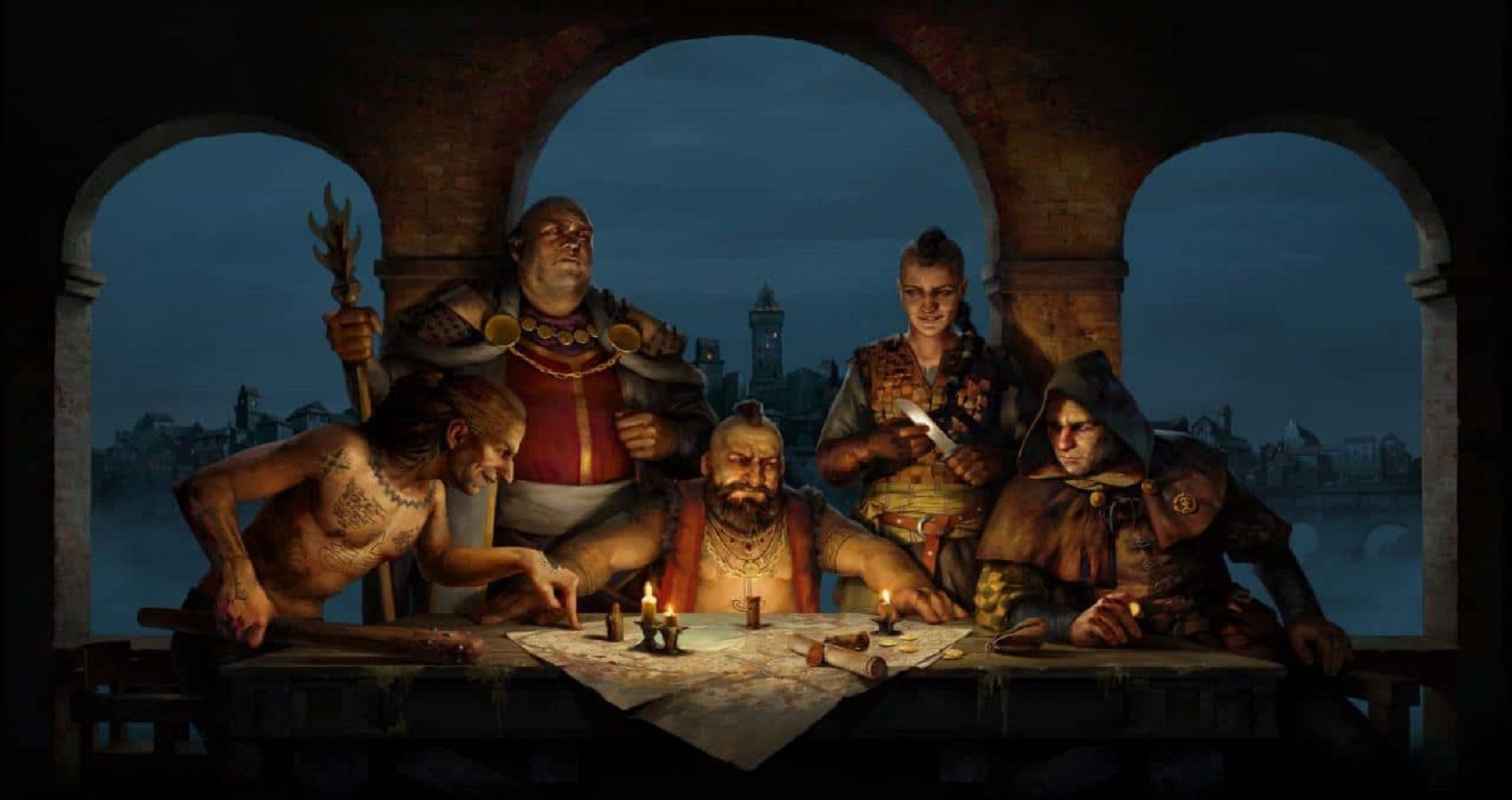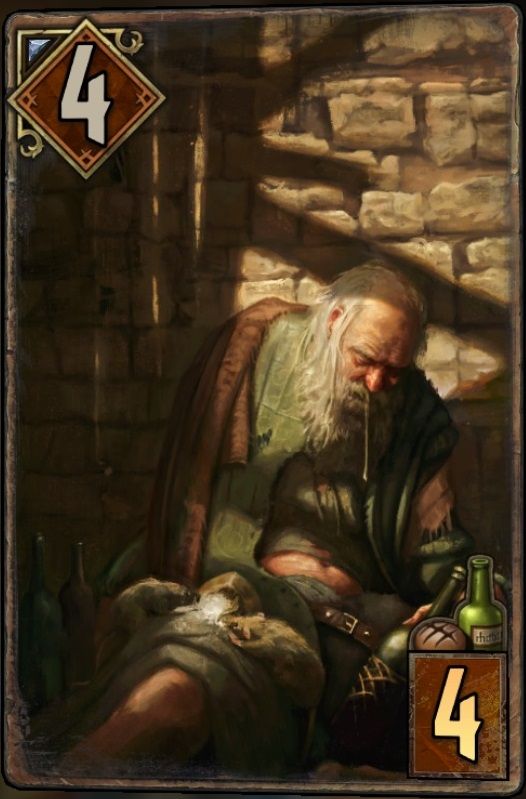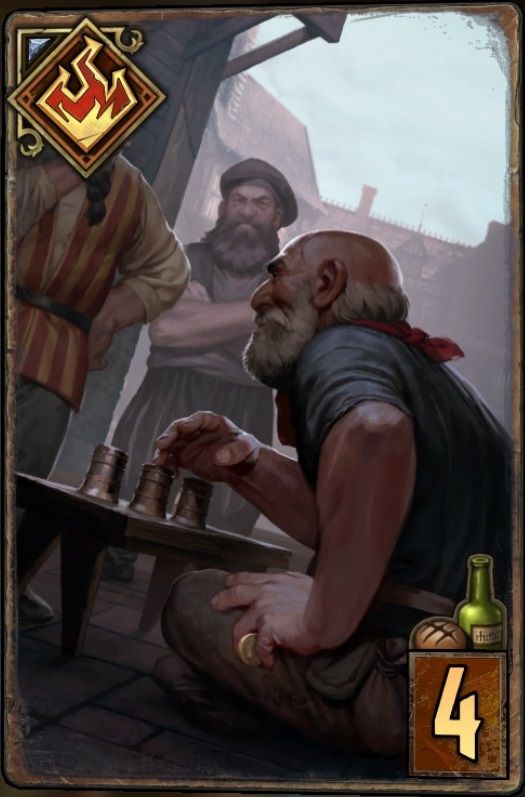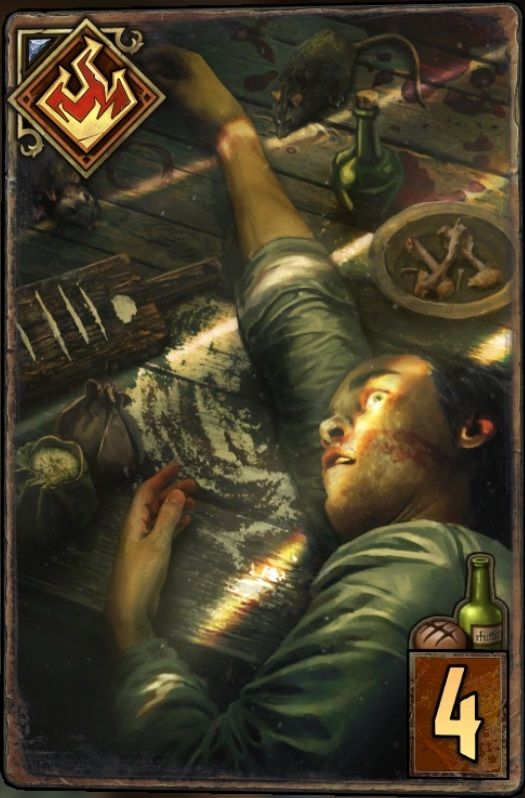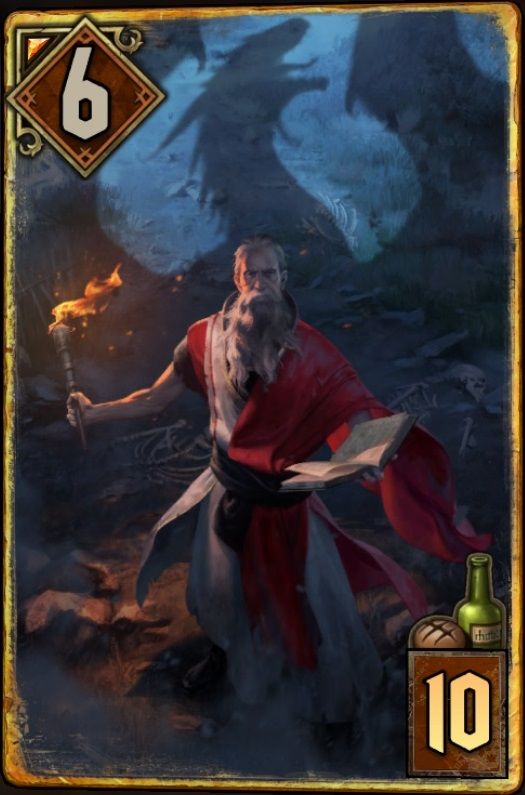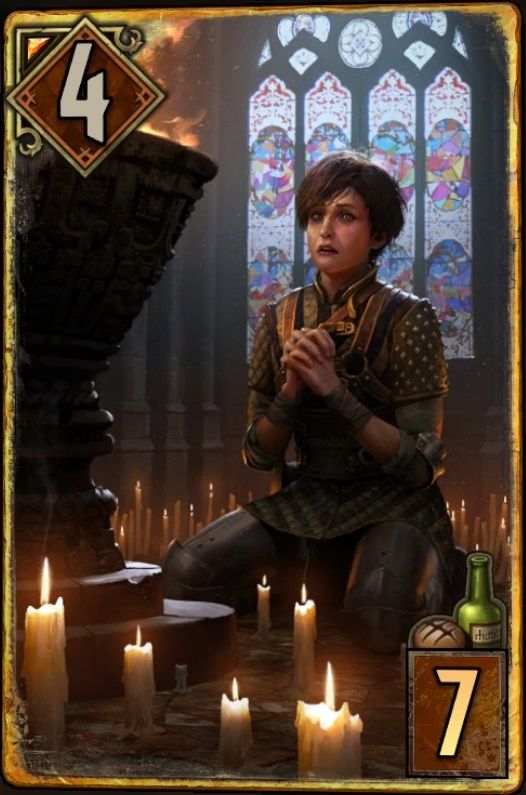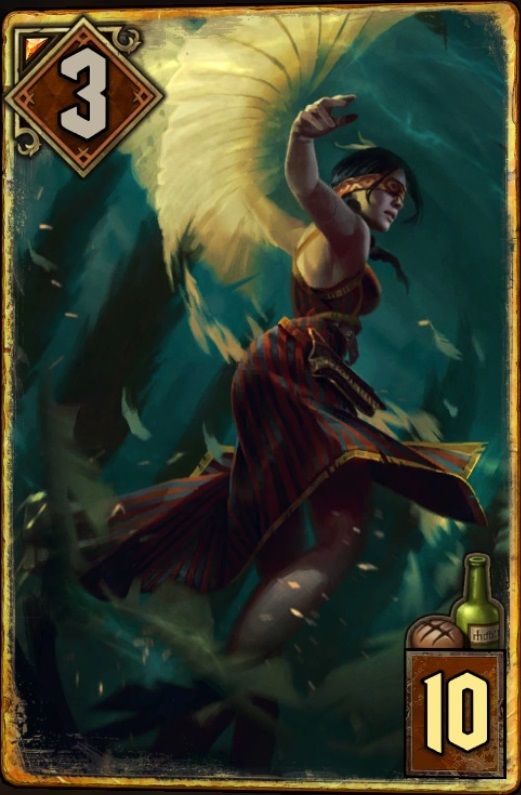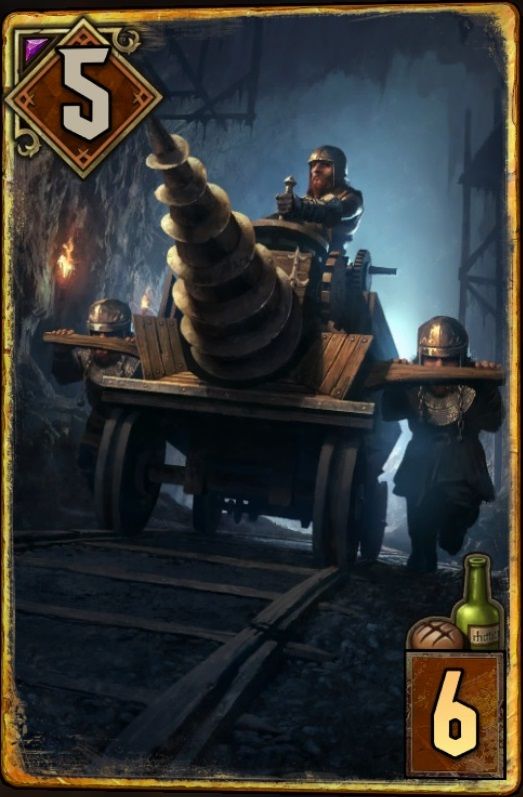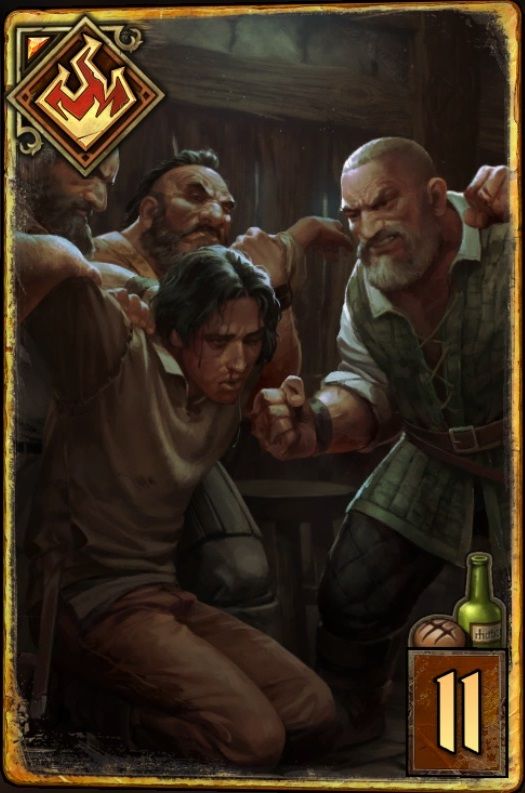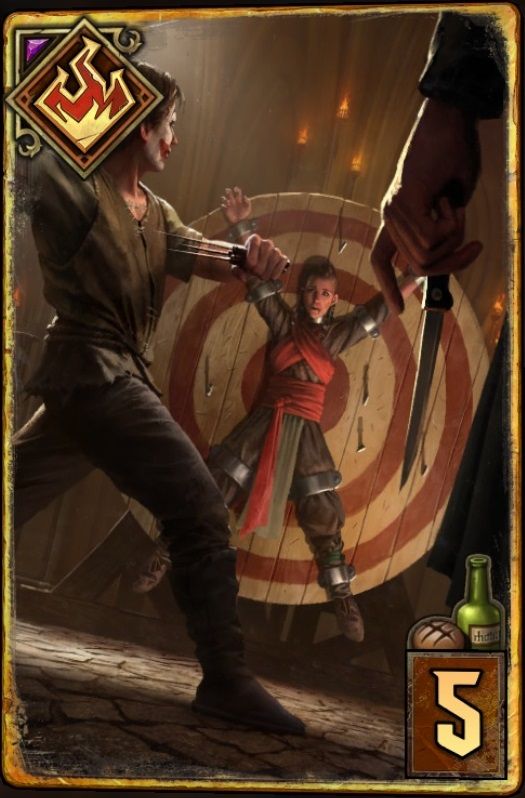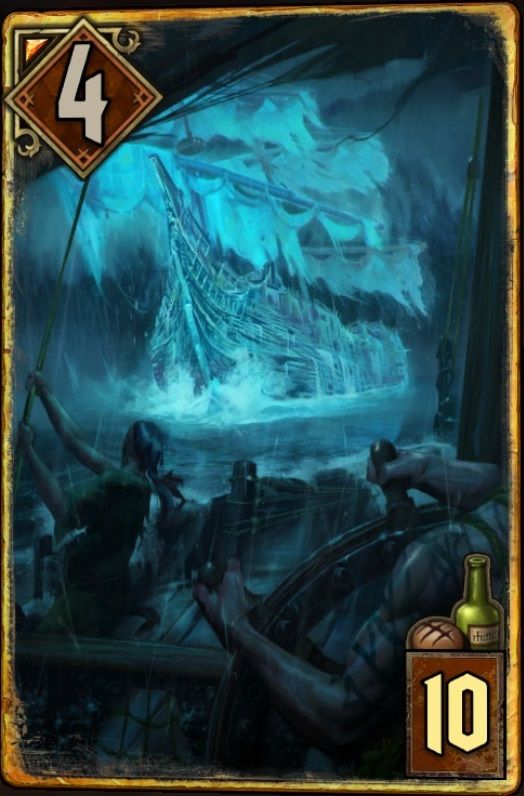The latest expansion for Gwent: The Witcher Card Game released late June, with nearly a hundred new cards for players to have fun with. The new content is based around the free city of Novigrad and the various gangs and criminals that call it home. From priests of the Eternal Fire, to vicious beasts in the underground arenas, to the beggars and vagabonds that roam the streets, the newest faction – the Syndicate – welcomes them all. Many of the new cards are fantastic, with powerful abilities to shift the balance of the game, while others are decidedly less so. Here are five of the best (and worst) new cards introduced in the Novigrad expansion.
10 Worst: Wretched Addict
The wretched addict is an interesting and flavorful card that may very well see play, but the nature of its ability makes it inherently fragile, depending on how the metagame evolves. Essentially, the Wretched Addict is a card that boosts itself by two on turn end if it has the poison status. In some matchups, this could prove very useful for the Syndicate as they have a powerful engine generating two points per turn. Against an opponent who is also playing poison, though, the Wretched Addict is effectively a dead card as it can easily be destroyed by simply giving it another instance of poison. While it is certainly fascinating how well the mechanics of the card match the character, the Wretched Addict is certainly one of the less impressive units available to the Syndicate.
9 Best: Swindle
The featured new mechanic of the Novigrad expansion is coins – cards that generate them, cards that spend them, and cards with special abilities if you possess enough of them. From the provision costs of the new cards, it's clear the game treats gaining one coin as equal to one provision point, and that is why Swindle is such a useful card. It has four provision, but randomly generates four, five, or six coins when played. This means that while it may not be the most consistent card, you will always be able to get at least full value out of the provision spent on including it in the deck – and sometimes, you can get even more.
8 Worst: Fisstech
Fisstech is one of the few cards introduced that is meant to work with the Wretched Addict mentioned above, and as such it shares some of the same failings. While you can certainly use it to poison an enemy unit, the Syndicate doesn’t really have many cards that incentivize that like Nilfgaard or Scoia'tael. Fisstech also generates three coins, but there are numerous better options for amassing them, such as Swindle mentioned above. There may yet be a spot for it in a very specific sort of deck, but as things stand, Fisstech is not likely to see much play.
7 Best: Prophet Lebioda
One of the big changes in the Novigrad expansion the introduction of dual faction cards. Prophet Lebioda is one such card, as he can be played in both Syndicate decks and Northern Realms decks, lending him a great deal of versatility. His ability is also nothing to shy away from as he gives any unit played next to him a shield, protecting them from the next instance of damage they would take. This has a great deal of promise for Northern Realms engines, which would benefit from Lebioda's protection, as well as for the Syndicate's various essential units. Expect to see Prophet Lebioda across a wide range of builds, playstyles, and – of course – factions.
6 Worst: Tamara Strenger
Tribal decks are focused around a card with a certain category, such as Witchers or Dwarfs. Novigrad introduces the possibility of Witch Hunter tribal, with numerous cards sharing that tag. However, most of the Syndicate decks currently in play seem focused on generating, spending, and hoarding coins – not necessarily on Witch Hunters. While some cards with that tag do show up in several popular decks, there aren't nearly enough of them to really justify including a card like Tamara Strenger, which can boost all Witch Hunters on the board, in the deck, and in your hand. This is certainly a powerful ability, but the absence of popular Witch Hunter-centric decks mean that it isn't going to be game-changing.
5 Best: Philippa Eilhart
Philippa Eilhart is a character from the Witcher universe who appeared back in Gwent's beta but disappeared with Homecoming and the full release. She's back in the Novigrad expansion, although with a very different (but no less powerful) ability. Whereas in the beta she could damage enemies by a cascading amount, this new incarnation has a deploy ability that allows you to spend an amount of coins equal to an enemy units to power to move it over to your side of the board. Since players can have up to nine coins total, this promises to be a versatile and effective way of not only dealing with your opponent's threats, but also claiming them for your own.
4 Worst: Tunnel Drill
Artifacts and artifact removal in Gwent have been a tricky thing to balance in the past and while this next card certainly isn't the worst card to put in your deck, its uses are debatable. Tunnel Drill grants you one coin when played, and then allows you to spend three coins if it's in the melee row to destroy an artifact. Given the disparity between its coin generation and expenditure, it's already on shaky ground. While Tunnel Drill can have its uses, unless you’re very worried about an artifact running away with the game, there are likely better choices for your deck.
3 Best: Novigradian Justice
Another dual faction card, Novigradian Justice is powerful in several different ways. First and foremost, it allows you to play any bronze unit from your deck, useful if you need to respond to something immediately or you want to make a strong proactive move. Its second ability is what stands out, though – if the unit has the Dwarf tag, you spawn and summon a second copy of it, effectively allowing you to play two units at once. Aside from the base power gain and whatever effects the units have, you also get to thin your deck, making your future draws more consistent and setting you one step further on the path to victory.
2 Worst: Wheel Of Fortune
Some gold cards are well worth their provision cost – and some can be worth much, much more. Wheel of Fortune, however, simply isn't. Randomness in a game of strategy and deliberation is always of debatable value, with some instances being nigh unplayable (Gascon, we’re looking at you) while others sometimes see play at tournaments (such as fan favorite card Shupe's Day Off). Wheel of Fortune falls into the former category, unfortunately, as it deals a random amount of damage between one and ten. With a bit of luck, this card can be worth much more than its provision cost – but about half the time, it won't. That sort of inconsistency makes Wheel of Fortune a card that will likely not see much play the way the game is now.
1 Best: The Flying Redanian
The Flying Redanian takes its name from the Flying Dutchman of legend, and its power in-game is equally legendary. If a player manages to collect nine coins, The Flying Redanian will be summoned to the board – even if it’s in the graveyard. Many Syndicate leaders will be able to make good use of this ability, such as Gudrun Bjornsdottir who can instantly generate nine coins. Others, like Cyrus Hemmelfart and Whoreson Junior, will also be able to utilize it well. Combining both deck-thinning and its ability to be summoned to the board in multiple rounds, The Flying Redanian is possibly the best new card of the expansion.

